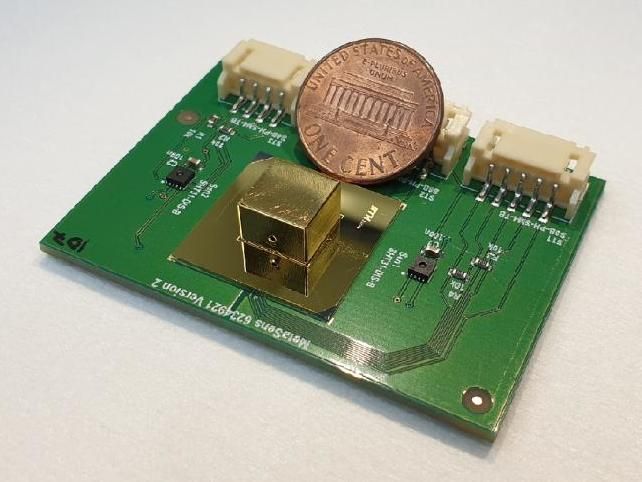First all-metamaterial optical gas sensor
Researchers have developed the first fully-integrated, non-dispersive infrared (NDIR) gas sensor enabled by specially engineered synthetic materials known as metamaterials. The sensor has no moving parts, requires little energy to operate and is among the smallest NDIR sensors ever created.

The miniature all-metamaterial optical gas sensor (golden capsule) next to a one-cent coin.
Alexander Lochbaum, ETH Zurich
The sensor is ideal for new Internet of Things and smart home devices designed to detect and respond to changes in the environment. It also could find use in future medical diagnostics and monitoring equipment.
A paper explaining these results will be presented at the Frontiers in Optics + Laser Science (FIO + LS) conference, held 15-19 September in Washington, D.C., U.S.A.
"Our sensor design unites simplicity, robustness, and efficiency. Using metamaterials, we can omit one of the main cost drivers in NDIR gas sensors, the dielectric filter, and simultaneously reduce the size and energy consumption of the device," said Alexander Lochbaum from the Institute of Electromagnetic Fields of ETH Zurich, Switzerland, and lead author on the paper. "This makes the sensors viable for high-volume, low-cost markets such as automotive and consumer electronics."
NDIR sensors are among the commercially most relevant types of optical gas sensors, used to assess vehicle exhaust, measure air quality, detect gas leaks and support a variety of medical, industrial and research applications. The new sensor's small size, potentially low cost, and reduced energy requirements open new opportunities for these and other types of applications.
Shrinking the optical pathway
Conventional NDIR sensors work by shining infrared light through air in a chamber until it reaches a detector. An optical filter positioned in front of the detector eliminates all light except the wavelength that is absorbed by a particular gas molecule so that the amount of light entering the detector indicates the concentration of that gas in the air. Though most NDIR sensors measure carbon dioxide, different optical filters can be used to measure a wide range of other gases.
In recent years, engineers have replaced the conventional infrared light source and detector with microelectromechanical systems (MEMS) technology, miniscule components that bridge between mechanical and electrical signals. In the new work, researchers integrate metamaterials onto a MEMS platform to further miniaturize the NDIR sensor and dramatically enhance the optical path length.
Key to the design is a type of metamaterial known as a metamaterial perfect absorber (MPA) made from a complex layered arrangement of copper and aluminum oxide. Because of its structure, MPA can absorb light coming from any angle. To take advantage of this, the researchers designed a multi-reflective cell that "folds" the infrared light by reflecting it many times over. This design allowed a light absorption path about 50 millimeters long to be squeezed into a space measuring only 5.7 × 5.7 × 4.5 millimeters.
Whereas conventional NDIR sensors require light to pass through a chamber a few centimeters long to detect gas at very low concentrations, the new design optimizes light reflection to accomplish the same level of sensitivity in a cavity that is just over half a centimeter long.
A simple, robust, and low-cost sensor
By using metamaterials for efficient filtering and absorption, the new design is both simpler and more robust than existing sensor designs. Its main parts are a metamaterial thermal emitter, an absorption cell, and a metamaterial thermopile detector. A microcontroller periodically heats up the hotplate, causing the metamaterial thermal emitter to generate infrared light. The light travels through the absorption cell and is detected by the thermopile. The microcontroller then collects the electronic signal from the thermopile, and streams the data to a computer.
The primary energy requirement comes from the power needed to heat the thermal emitter. Thanks to the high efficiency of the metamaterial used in the thermal emitter, the system works at much lower temperatures than previous designs, so less energy is needed for each measurement.
The researchers tested the device's sensitivity by using it to measure varying concentrations of carbon dioxide in a controlled atmosphere. They demonstrated it can detect carbon dioxide concentrations with a noise-limited resolution of 23.3 parts per million, a level on par with commercially available systems. However, to do this the sensor required only 58.6 millijoules of energy per measurement, about a five-fold reduction compared to commercially available low-power thermal NDIR carbon dioxide sensors.
"For the first time, we realize an integrated NDIR sensor that relies exclusively on metamaterials for spectral filtering. Applying metamaterial technology for NDIR gas sensing allows us to rethink the optical design of our sensor radically, leading to a more compact and robust device," said Lochbaum.
Other news from the department science
Most read news
More news from our other portals
See the theme worlds for related content
Topic world Sensor technology
Sensor technology has revolutionized the chemical industry by providing accurate, timely and reliable data across a wide range of processes. From monitoring critical parameters in production lines to early detection of potential malfunctions or hazards, sensors are the silent sentinels that ensure quality, efficiency and safety.

Topic world Sensor technology
Sensor technology has revolutionized the chemical industry by providing accurate, timely and reliable data across a wide range of processes. From monitoring critical parameters in production lines to early detection of potential malfunctions or hazards, sensors are the silent sentinels that ensure quality, efficiency and safety.




























































